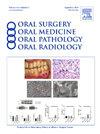范可尼贫血鳞状细胞癌的无创检测技术
IF 1.9
3区 医学
Q2 DENTISTRY, ORAL SURGERY & MEDICINE
Oral Surgery Oral Medicine Oral Pathology Oral Radiology
Pub Date : 2025-07-21
DOI:10.1016/j.oooo.2025.04.024
引用次数: 0
摘要
范可尼贫血(FA)患者患鳞状细胞癌(SCC)的风险异常高,主要影响舌头和口腔黏膜。FA是由参与FA/BRCA DNA修复通路的22个基因(如FANCA、FANCD1)中的一个的双等位种系致病变异引起的;该通路功能障碍预示着SCC的风险增加20-50倍。骨髓衰竭患者接受造血细胞移植后,FA患者的生存期延长了20年~ 40岁。因此,对于FA患者,建议从小开始定期监测SCC。癌症的早期发现和治疗可以改善结果并增加生存机会。材料和方法我们设计了一项纵向研究(NCT00027274),以了解口腔癌前病变(OPL)的自然历史,并促进FA患者中SCC的拦截。个人(N = 200;>;8岁)将被纳入5年,并前瞻性随访10年。受试者将接受年度全面的癌症筛查,包括数字口内扫描和口腔刷活检,以检查口腔上皮发育不良和口腔鳞状细胞癌的证据,并在必要时对opl进行切除活检。前瞻性细胞病理学结果将与DNA倍体和组织病理学分级的变化纵向相关,以确定口腔刷细胞学和DNA细胞术在预测临床可操作的异常增生和SCC方面的敏感性和特异性。结果本研究的主要结果指标将确定口腔筛查在描述口腔外伤性口疮自然病史方面的成功程度。次要探索性结果测量将有助于确定口腔鳞状细胞癌发展的预测性生物标志物,并可能有助于对可能需要侵入性、经常重复的活检手术的患者进行风险分层。结论:这是一项纵向的自然病史研究,将帮助我们确定刷活检在FA患者中识别口腔发育不良和SCC的效用。本文章由计算机程序翻译,如有差异,请以英文原文为准。
Noninvasive technique of detection of squamous cell carcinoma in Fanconi anemia
Introduction
Individuals with Fanconi anemia (FA) have an exceptionally high risk of squamous cell carcinoma (SCC) and predominantly affects the tongue and oral mucosa. FA is caused by biallelic germline pathogenic variants in one of >22 genes (e.g., FANCA, FANCD1) involved in the FA/BRCA DNA repair pathway; dysfunction in this pathway portends a 20-50-fold increased risk of SCC. Hematopoietic cell transplantation for bone marrow failure has extended the survival of FA patients by ∼20 years with patients living into their 40s. Therefore, regular monitoring for SCC is recommended for FA starting at a young age. Early detection and treatment of cancers can improve outcomes and increase the chances of survival.
Materials and Methods
We designed a longitudinal study (NCT00027274) to understand the natural history of oral premalignant lesions (OPL) and facilitate interception of SCC in individuals with FA. Individuals (N = 200; >8 years of age) will be enrolled over 5 years and followed prospectively for 10 years. Subjects will receive annual comprehensive cancer screening including digital intraoral scanning and oral brush biopsy to examine for evidence of oral epithelial dysplasia and oral SCC, and excisional biopsy of OPLs when warranted. Prospective cytopathological findings will be correlated with changes in DNA ploidy and histopathological grade longitudinally to determine the sensitivity and specificity of oral brush cytology and DNA cytometry in predicting clinically actionable dysplasia and SCC.
Results
The primary outcome measure of the study will define the success of oral screening in characterizing the natural history of OPLs. Secondary exploratory outcome measures will help to identify predictive biomarkers of oral SCC development and possibly help risk stratify patients who may require invasive, oftentimes repeated, biopsy procedures.
Conclusions
This is longitudinal natural history study will help us to determine the utility of brush biopsy to identify oral dysplasia and SCC in FA patients.
求助全文
通过发布文献求助,成功后即可免费获取论文全文。
去求助
来源期刊

Oral Surgery Oral Medicine Oral Pathology Oral Radiology
DENTISTRY, ORAL SURGERY & MEDICINE-
CiteScore
3.80
自引率
6.90%
发文量
1217
审稿时长
2-4 weeks
期刊介绍:
Oral Surgery, Oral Medicine, Oral Pathology and Oral Radiology is required reading for anyone in the fields of oral surgery, oral medicine, oral pathology, oral radiology or advanced general practice dentistry. It is the only major dental journal that provides a practical and complete overview of the medical and surgical techniques of dental practice in four areas. Topics covered include such current issues as dental implants, treatment of HIV-infected patients, and evaluation and treatment of TMJ disorders. The official publication for nine societies, the Journal is recommended for initial purchase in the Brandon Hill study, Selected List of Books and Journals for the Small Medical Library.
 求助内容:
求助内容: 应助结果提醒方式:
应助结果提醒方式:


